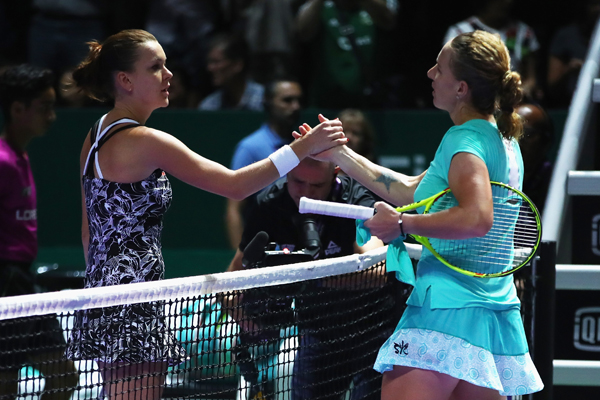Insider Reacts: Four Thoughts On Kerber's Decisive Win Over Halep In Singapore
SINGAPORE – World No.1 Angelique Kerber took control of the Red Group on Tuesday, beating No.4 Simona Halep 6-4, 6-2 to move perilously close to qualifying for her first semifinals at the BNP Paribas WTA Finals Singapore presented by SC Global.
Read how the match unfolded in the WTA Insider Live Blog.
– This is the Kerber we’ve watched all year.
There were questions surrounding Kerber coming into Singapore. She was, arguably, the least in-form player in the Red Group and had not played particularly well since the US Open. But through two matches now, especially in her win over Halep, she’s proved to herself and everyone else that she’s ready to play.
Kerber’s defense and counter-punching was top notch against Halep. She prolonged rally after rally with her speed into the tramlines and then pounced on anything Halep left short. The decision-making was there, the shots were there, and most importantly, the confidence was there.
This was the Angelique Kerber who can win this tournament.
The dropper of the highest order from @angeliquekerber! #WTAFinals pic.twitter.com/iOVgdzp45C
— WTA (@WTA) October 25, 2016
– The two “Fs” let Halep down.
The Romanian played well in spurts and she deserved a better scoreline for her efforts, but her forehand and finishing let her down. As she battled hard to penetrate Kerber’s defensive shell, she lacked the rhythm on her forehand side to pressure Kerber consistently. Halep chalked it up to a bad day at the office.
“The court here is slow and the ball doesn’t bounce,” Halep said. “Her balls are very low, so it’s tough to go from down, deep down, to make a winner.
“So I tried just to restart the points all the time, and just when I had the opportunity, good opportunity to finish the ball, I took it. But I missed a lot with the forehand, so I think that was the problem.”
Coach @Darren_Cahill telling @Simona_Halep to hit the high balls hard. Can she comeback? #WTAFinals pic.twitter.com/VgJ0AD7i0P
— WTA (@WTA) October 25, 2016
– Kerber will qualify for her first semifinals if she wins a set, though she may not have to.
On Thursday, Halep will face Dominika Cibulkova in the first singles match (starting at 4pm local time) and Kerber will follow against Madison Keys (starting at 7:30pm). The only scenario in which Kerber does not qualify out of the group stage is if Halep beats Cibulkova in straight sets and Kerber loses to Keys in straight sets. If she wins a set, she’s through.
To the extent there may be additional pressure on Kerber, she’ll know the result of the Halep match before she takes the court. If Halep goes three sets, meaning Cibulkova wins one set, Kerber is through as well. But if Halep wins in straight sets, Kerber will know she has to win a set off Keys to qualify. The good news for the German is that she’s won five of her six matches against Keys.
Turning point: @AngeliqueKerber saves break point at 3-4, goes on to win nine of last 11 games vs Halep @WTAFinalsSG pic.twitter.com/mCxuZ2v70q
— WTA Insider (@WTA_insider) October 25, 2016
A cornerstone of Kerber’s 2016 story is of course her failure to pull off this very feat 12 months ago. Last year, Kerber took the court in Singapore knowing she just needed to win a set off an ailing Lucie Safarova to advance. She lost in straights.
“Of course I have much more confidence right now because I know how to win very big matches, tight matches,” Kerber said. “I know what to do to go for it and just take the game in my hands. Of course I believe much more in my game and in myself than like 12 months ago, especially after Singapore one year ago.”
The press conference for @Simona_Halep, who is still well alive in @WTAFinalsSG! #WTAFinals https://t.co/M0hdDW5SsR pic.twitter.com/z9eJLDiSw9
— WTA (@WTA) October 25, 2016
– Kerber’s biggest fan on Thursday? Halep.
While Kerber’s fate is entirely in her hands on Thursday, Halep needs some help from Kerber. And so the vanquished becomes the cheerleader.
If Kerber wins on Thursday, the only scenario in which Halep would not advance is if she loses in straight sets to Cibulkova. Taking a single set off the Slovak would put her through so long as Kerber wins.
But if Keys beats Kerber in straight sets, and Halep loses a set to Cibulkova, she’s out.
How do you say “Auf geht’s Angie!” in Romanian?





